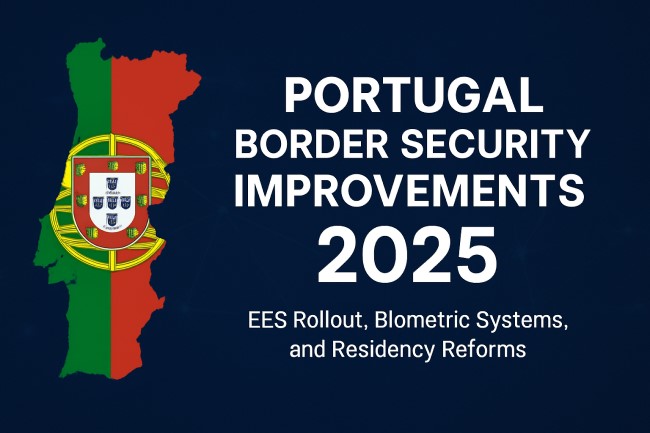Portugal Border Security Improvements: EES Rollout, Biometric Systems, and Residency Reforms 2025

Portugal is undergoing a major transformation in how it secures its borders and manages migration. As part of broader EU-wide initiatives and national reforms, the country is deploying advanced biometric technology, restructuring its border agencies, and tightening its immigration and residency policies. These changes, especially those set in motion throughout 2025, aim to strengthen national security, ensure smoother border crossings, and align Portugal with modern EU standards.
In this article, we will explore the key Portugal border security improvements, from the implementation of the Entry/Exit System (EES) to changes in citizenship and residency rules. These updates reflect a combination of digital innovation, institutional reform, and stricter policy enforcement.
Portugal’s Modern Border Vision
A New Era of Digital Borders
Portugal is moving away from traditional manual passport checks toward a more digitized border experience. With the rollout of the EU’s Entry/Exit System, all non-EU travelers entering and exiting the Schengen Area will soon be registered biometrically.
This system is not just about convenience. It plays a critical role in identifying overstays, catching false identities, and streamlining the flow of people. For Portugal, which hosts millions of tourists and a growing expat community, these tools offer the opportunity to strengthen national security while improving efficiency.
Institutional Restructuring: The End of SEF
The Dissolution of the Foreigners and Borders Service
One of the most significant shifts in Portugal’s border policy was the dissolution of the Foreigners and Borders Service (SEF) in late 2023. SEF was responsible for border control, immigration enforcement, and visa management. In its place, several new institutions and agencies have taken over its roles, each specializing in different areas.
Who Took Over SEF’s Responsibilities?
-
Public Security Police (PSP): Now manages airport border control and other internal security operations.
-
National Republican Guard (GNR): Oversees land and sea borders.
-
Agency for Integration, Migration and Asylum (AIMA): Handles administrative immigration tasks like residence permits and asylum requests.
-
Judicial Police: Assumes responsibility for criminal investigations formerly managed by SEF.
This shift allows each agency to focus more efficiently on their specific tasks, promoting professionalism and speeding up processes across the board.
Entry/Exit System (EES) – A Game Changer
What is the EES?
The Entry/Exit System is a large-scale EU database designed to record data of third-country nationals (non-EU citizens) who cross the external borders of the Schengen Area. It will store:
-
Biometric data (fingerprints and facial images)
-
Personal details
-
Entry and exit dates
-
Duration of permitted stay
Why is the EES Important for Portugal?
With millions of tourists, workers, and residents coming through Lisbon, Porto, Faro, and Madeira every year, Portugal’s border systems need to be both secure and efficient. EES enables automatic detection of overstays and reduces the reliance on manual passport stamping, which is prone to errors.
Implementation Timeline in Portugal
Portugal has already started deploying EES-compliant infrastructure at major ports and airports. The full system is expected to go live in October 2025, with continued optimization until April 2026. Major components include:
-
VIS4 (Visa Information System 4)
-
PASSE+ (National Air and Land Border Control System)
-
Portal Fronteiras (Borders Portal)
These systems together create a seamless, secure entry/exit process that helps manage rising traveler volumes while preserving security.
Challenges and Delays During the Transition
Initial Delays at Airports
While the new systems promise smoother border control in the long run, the early phases of deployment have faced issues. Long queues and extended processing times were reported at Lisbon and Porto airports due to system complexity and understaffing.
Government Response
To tackle these growing pains, Portugal hired over 500 new border agents and upgraded automated gates (RAPIDS). These reinforcements are helping to stabilize operations during the rollout of the EES and other technologies.
Residency and Citizenship Law Reforms
Key Changes in 2025
In addition to border security improvements, Portugal has introduced sweeping changes to its immigration and naturalization policies:
-
Residency Requirement for Citizenship: Increased from 5 years to 10 years.
-
Citizens of Portuguese-Speaking Countries (CPLP): Now eligible for citizenship after 7 years of residency.
-
Stricter Integration Tests: Including language proficiency and cultural knowledge exams.
-
End of Birthright Citizenship for Most: Children born in Portugal no longer receive automatic citizenship unless strict criteria are met.
End of “Expression of Interest” Model
Previously, immigrants in Portugal could gain legal residency by simply applying with an “expression of interest” while already living in the country. This system has been removed. Now, migrants must have a valid job offer before applying for a visa.
AIMA and the Immigration Backlog
The Backlog Problem
When SEF was dismantled, its successor AIMA inherited a massive backlog of over 400,000 pending residency applications. This led to widespread frustration among migrants trying to regularize their status.
Clearing the Path
In early 2025, the government allocated more funding and staff to AIMA, which helped reduce the backlog by over 200,000 applications. Additionally, residence permits that expired during this transition were automatically extended through June 2025, providing some relief to affected individuals.
UNEF: A New Force in Border Enforcement
Introduction of UNEF
In July 2025, the government created a new unit called Unidade Nacional de Estrangeiros e Fronteiras (UNEF). Operating within the PSP, UNEF will take over several key responsibilities:
-
Airport and seaport control
-
Deportation and detention operations
-
International police cooperation
-
Coordination with AIMA for visa matters
UNEF becomes operational in August 2025, promising better organization and consistency in enforcing Portugal’s updated border and immigration policies.
Looking Ahead
Portugal’s approach to border security and migration in 2025 marks a turning point in national policy. With EES technology, enhanced staffing, and new legal frameworks, the country is aligning itself more closely with European standards while responding to domestic security concerns.
At the same time, Portugal’s reforms also reflect a more selective immigration strategy, requiring greater integration efforts from those who wish to stay long-term.
Conclusion
Portugal’s border security improvements in 2025 are both ambitious and necessary. By embracing modern biometric systems, restructuring key agencies, and updating residency laws, the country is ensuring a more controlled and efficient migration environment. While the changes have not been without challenges, especially at busy airports, the long-term benefits in terms of safety, compliance, and processing speed are significant.



